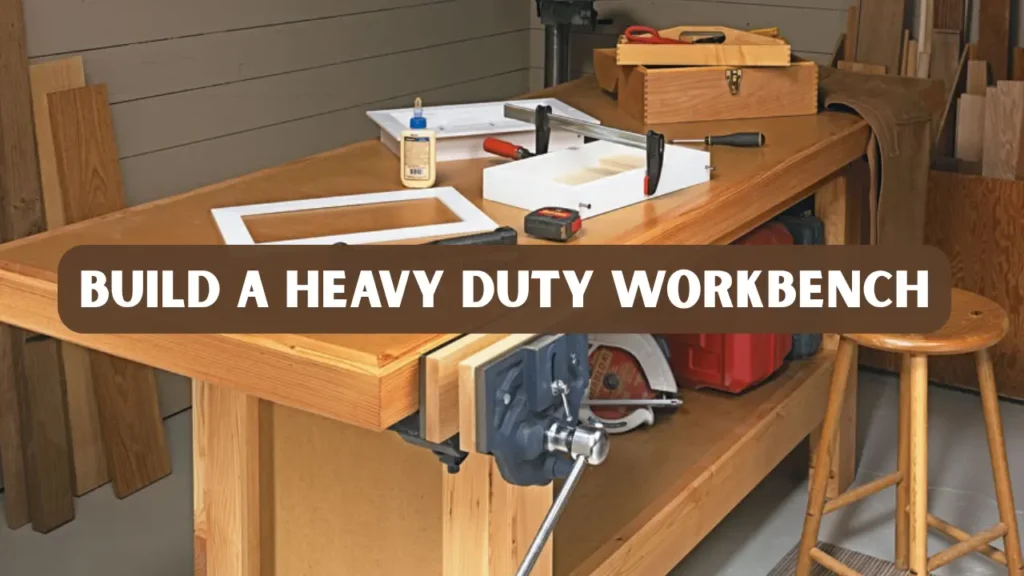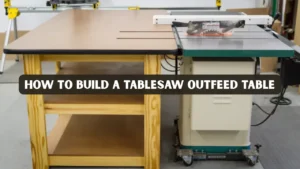Key Takeaways
- A heavy duty workbench is the foundation of any functional workshop, providing stability and support for various tasks.
- Proper planning, material selection, and construction techniques ensure durability and longevity.
- This guide provides detailed step-by-step instructions, expert tips, and practical advice to help you build your own workbench.
- Includes recommendations for maintenance, safety, and customization to suit different workshop needs.
Why You Need a Heavy Duty Workbench in Your Workshop
A heavy duty workbench is not just a table; it is the central hub of any workshop. It brings together precision, craftsmanship, and productivity in one reliable workspace. Whether you are a professional woodworker, metalworker, or a dedicated DIY enthusiast, it can significantly improve your work quality. Its sturdy design allows it to withstand cutting, hammering, drilling, and assembly tasks repeatedly.
This essential workshop piece provides a safe and stable surface for tools and materials. Choosing the right materials and construction techniques ensures long-term durability. Adding finishing touches and planning for maintenance further extends its lifespan. In this guide, we will explore everything you need to build a workbench suited for professional and personal projects.
Understanding the Essentials of a Sturdy Workshop Bench
Before starting construction, it is essential to understand what makes a workbench truly sturdy and reliable. Knowing the key features and materials that contribute to durability ensures you build a bench that can withstand heavy use and last for years.
Key Features
- Sturdy Frame: Capable of supporting heavy loads without wobbling.
- Durable Work Surface: Thick wood or reinforced plywood ensures long-lasting performance.
- Strong Legs: Usually made from 2×4 or 4×4 lumber, or steel for professional-grade stability.
- Support Braces: Cross braces or corner brackets prevent flexing.
- Optional Storage: Shelving, drawers, or pegboards for tool organization.
Materials to Consider
- Hardwood Lumber: Oak or maple for maximum strength.
- Softwood Lumber: Pine or fir for cost-effective solutions.
- Plywood or MDF: For the work surface or storage shelves.
- Hardware: Screws, brackets, and optional casters for mobility.
Selecting the right combination of materials ensures that your workbench remains functional and reliable for years.
Planning Your Workbench
Careful planning is the foundation of a durable workbench. Before starting construction, measure your workspace, decide on the dimensions, and choose materials wisely. A well-thought-out plan ensures stability, functionality, and long-term use, making the building process smoother and more efficient.
Determine the Dimensions
- Length: Typically 4 to 8 feet depending on workspace.
- Width: Between 2 to 4 feet for comfortable working.
- Height: Standard height is 34 to 36 inches but can be adjusted for ergonomic comfort.
Design Features
- Storage Solutions: Drawers, shelves, or tool racks to keep the workspace organized.
- Mobility: Casters allow you to move the bench easily if needed.
- Electrical Access: Consider built-in power strips for tools and devices.
A well-planned workbench not only enhances efficiency but also provides a safe and ergonomic working environment.
Materials Needed
Selecting the right materials is essential for building a durable workbench. Using high-quality wood and reliable hardware ensures the structure remains stable and strong. Proper material choices allow the bench to withstand heavy use and last for many years.
Frame and Legs
- Wood: Hardwoods like oak or maple are ideal for long-lasting performance.
- Metal Options: Steel or iron legs provide extra strength and durability.
Workbench Top
- Solid Wood: Provides the most durable work surface.
- Plywood: Strong and more affordable than solid wood.
- MDF: Smooth surface suitable for light-to-medium use, less durable under heavy loads.
Hardware and Accessories
- Heavy-duty screws for assembling the frame and top.
- Brackets or braces to strengthen joints.
- Optional casters for mobility.
Step by Step Guide
Step 1: Preparing Your Materials and Tools
Before construction, gather all necessary materials and tools.
- Tools Required: Saw, drill, clamps, measuring tape, level, square, sander.
- Materials List: Lumber for frame and legs, plywood or hardwood for the top, screws, brackets, casters, wood glue.
Proper preparation prevents delays and ensures smooth construction.
Step 2: Constructing the Frame
- Cut Lumber: Measure and cut lumber to the desired dimensions for the base frame.
- Assemble Frame: Use screws and brackets to create a square and sturdy frame.
- Attach Legs: Secure legs at each corner, ensuring they are perpendicular and stable.
Expert Insight: Reinforcing joints with corner brackets or dowels adds extra stability and prevents wobbling over time.
Step 3: Installing the Work Surface
- Prepare the Top: Cut plywood or hardwood to the dimensions of the frame.
- Secure the Top: Attach the work surface using screws and wood glue for a tight fit.
- Smooth the Surface: Sand edges and surfaces to remove splinters and rough spots.
Adding a thick, durable top ensures your workbench can withstand heavy use for years.
Step 4: Adding Storage and Accessories
- Lower Shelves: Install shelving beneath the work surface for storing tools and materials.
- Drawers: Add drawers for smaller items to keep the workspace organized.
- Optional Additions:
- Pegboard for tool storage
- Mounted vise for woodworking tasks
- Heavy-duty casters for mobility
Customization allows your workbench to meet both practical and aesthetic needs.
Step 5: Finishing Touches
- Sand All Surfaces: Ensure smooth edges to prevent injuries.
- Apply Protective Finish: Use polyurethane or oil-based sealants to protect wood from wear and moisture.
- Install Casters: If desired, attach heavy-duty casters for mobility.
Proper finishing not only enhances the appearance but also extends the life of your workbench.
Maintenance Tips for Longevity
- Keep It Clean: Regularly remove debris, dust, and scraps from the workbench. A clean surface prevents damage and ensures safety while working.
- Check Fasteners: Periodically tighten screws, bolts, and brackets to maintain stability. Loose hardware can cause wobbling or unsafe conditions.
- Protect the Surface: Use mats, boards, or sacrificial layers for heavy-duty projects. This prevents scratches, dents, and other wear on the work surface.
- Inspect Regularly: Look for cracks, splits, or weak joints in the frame and legs. Reinforce or repair any issues promptly to keep the workbench reliable.
Consistent maintenance ensures your workbench remains a reliable workspace for years to come.
Expert Advice for a Professional-Grade Workbench
- Customization: Tailor your heavy duty workbench to include features like integrated clamps, vises, or dedicated tool holders. These additions improve efficiency and keep tools within easy reach.
- Lighting: Incorporate task lighting above or around your workspace to reduce eye strain. Proper lighting ensures precision during detailed projects.
- Ergonomics: Make sure the height and layout of your workbench suit your comfort and the type of work you perform. An ergonomic setup prevents fatigue and increases productivity.
- Material Quality: Use high-quality hardwoods and reliable hardware to ensure the workbench lasts for years. Durable materials maintain stability under heavy use.
Case Studies
- John, a woodworking instructor, built a heavy duty workbench using oak and 2×4 pine with reinforced brackets, drawers, and a mounted vise, and it has remained durable after two years of daily use.
- Sarah, a DIY enthusiast, made a compact workbench with plywood and pine, adding a lower shelf and tool hooks, and it has proven sturdy and reliable for over a year.
Conclusion
Constructing a heavy duty workbench is an investment in your workshop’s functionality, efficiency, and safety. By carefully selecting materials, planning dimensions, and following structured construction steps, you can create a workbench that will serve you reliably for years.
A professional-grade workbench not only supports your projects but also enhances workflow, reduces strain, and provides a central hub for creativity. Adding features such as storage, vises, and ergonomic design ensures a workspace tailored to your needs.
Frequently Asked Questions
How thick should the top of a workbench be?
The ideal thickness ranges from 1.5 to 2 inches. Solid hardwood tops offer the best durability for heavy-duty tasks.
Is it possible to build a sturdy workbench on a budget?
Yes, using softwoods for the frame and a plywood top can create a cost-effective yet sturdy workbench.
Are casters essential for a workbench?
Casters are optional but useful for mobility. Heavy-duty locking casters provide stability while allowing flexibility.
What is the recommended height for comfort?
The standard workbench height is 34 to 36 inches. Adjust based on personal comfort or the type of work being performed.
Should I add a vise or clamps?
A mounted vise is highly recommended for woodworking and assembly tasks, improving precision and control.




